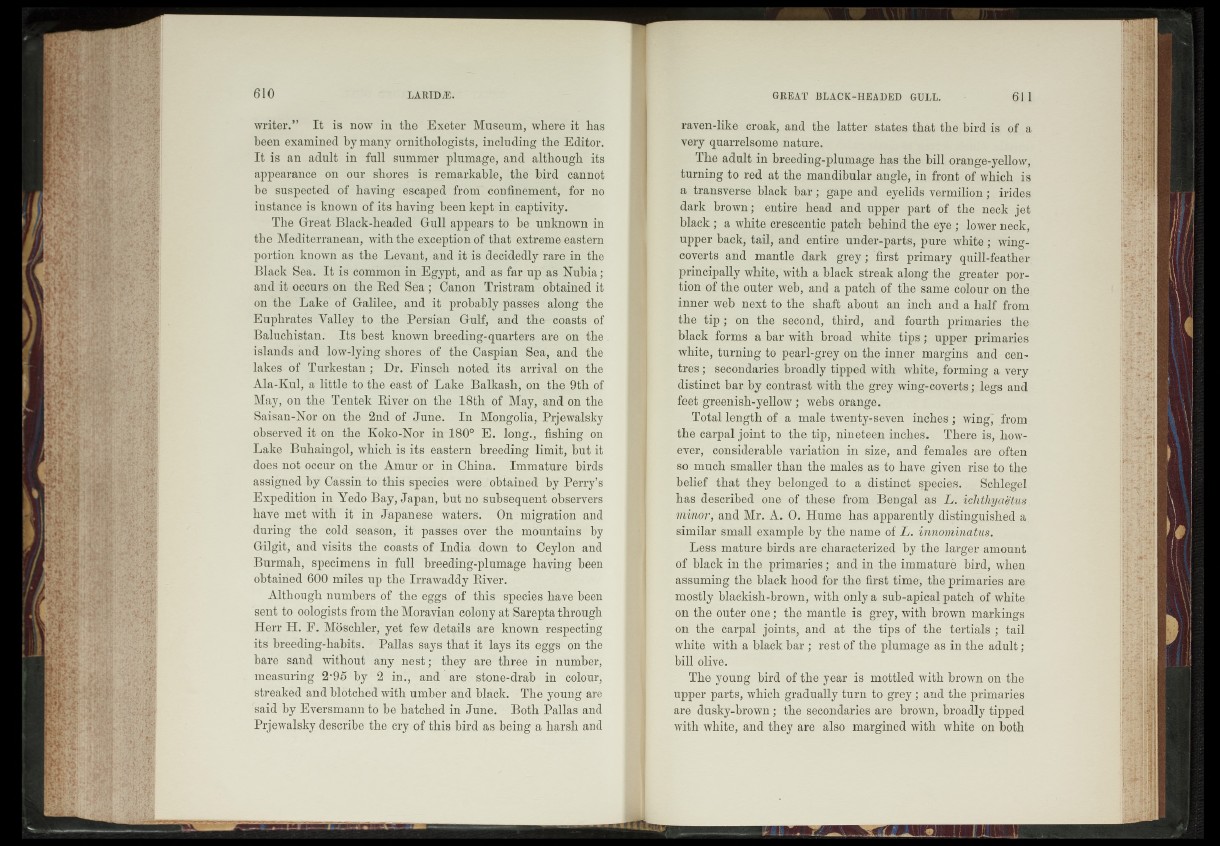
writer.” It is now in the Exeter Museum, where it has
been examined by many ornithologists, including the Editor.
It is an adult in full summer plumage, and although its
appearance on our shores is remarkable, »thé bird cannot
be suspected of having' escaped'from, confinement, for no
instance is known of its having been kept in. captivity.
The Great Black-headed Gull appears to be unknown in
the Mediterranean, with the exception of that extreme eastern
portion . known as the Levant, and it is decidedly rare in-the
Black Sea.; I£ is common in Egypt, and as far up as Nubia ;
andflt occurs . on ’ the Red Sea; | Canon Tristram ’ obtained it
on the Lake of Galilee, and it probably passes along the
Euphrates Valley to the Persian Gulf* and the- coasts of
Baluchistan. Its best known breeding-quarters are on the
islands and low-lying shores of Caspian Sea, and the
lakes of Turkestan; Dr. Einsch noted - its arrival on the
Ala-Kul, a1 little to the east of Lake Balkash, qn'>the 9th of
May, on'the Tentek River, on the 1.8th of May,-and on the
Saisan-Nor’on the 2nd of-June. In Mongolia, Frjewalsky
observed it on the Koko-Nor in i|;Ö° ‘È; long., fishing oh
Lake Buhaingol, which i^its eastern breeding limit, b,ut it
does, not occur on the Amur or in China. Immature birds
assigned by- Cassin, to-this speciès were/obtain éffjby Perry’s
Expedition in Yedo Bay, Japan, but no subsequent observers
have met with it' in Japanese waters. On migration and
during "the cold season, itv passes over the mountainsf by
Gilgit, and visrtsrthe' cóaMsöf India-down :tQ~‘C.ejlon and
Burmah, specimens in fjfl breeding-plumage having“ been
Obtained’ 6Ö0 miles uplhe Irrawaddy River. -
Although numbers "of théJ of this“ species llfave- been
'sent to uelogisfe from the Moravian colhny-at Sarepta through
Herr H. E. Moschler, yet few'details are known respecting
its breeding-habits: >r,Pallas’says that it lays its eggs1 on the
bare sand without any nest; they are three in number,
measuring 2'954 b’ylr2'/in/, and *are - sfone-drab in Uöïour,
streaked and-bldtehed with umber and black. j The -young are
'said by Eversmannto be hatched in June. '*-Both Pallas and
Prjewalsky describe the-cry; of this bird^ as-being a harsh and
raven-like croak, and the latter: states that the bird is of a
very quarrelsome nature.
The adult in breeding-plumage has the bill orange-yellow,
turning to red at the mandibular angle, in front of whi.ch is
a transverse black bar; gape and eyelids vermilion;. irides
dark brown; entire, head and upper part of the neck j;§.t
' black.; a white crescentic patch- behind the eye ;-lower neck,
upper back, tail, and entire under-parts, pure white; wing-
coverts and mantle dark grey; first primary quill-feather
priucipally white, with a black streak along.fhe, greater portion
of the outer web, and a patch,©f the sa-ipe colour on the.
inner web next to the, shaft about an inch and a half from,
-the tip ; on the second, third, and fourth primaries t^g
black forms a bar with broad white, .tips; upper primaries
white, turning to pearl-gijey-Qn.the inner margins and centres
; secondaries, broadly tipped with white, forming a very
distinct bar, by contrast- with the grey wing-coverts;. legs and
; feet greenish-yellow; webs ©range,-/
* TotaHength ©f a male twentylgCven inches; wimg7 Jriun,
the carpal joint t.6 the, tip,- nineteen in^hciK There ^„.ho’iVn,
^hver, considerable: variafiduMm „size, and females are often
soi much smaller thanp^hjpiaigs ;as to have,/giv©n, • rise to the
belief that „they beiongedr&tqq a. 4i$tinct, species.i a
has describe^ene.. of these from Bengal as L ,f ioMh^aeMs,
;W,kior,.. and Mr. A.H.„,Hume has apparently distmgujsh§d>a„
similar small example/byrihe’ name of. L. „
/siLess'mature bicds^arM^i&aietgrizejd, by the larger amount
of’hlack in the primaries..; - an J, in -the. immature,, hhd, /when
^assuming the black hd.o<i for the -first. time, f he primaries are
mostly blackish -brown, with only a sub-apical patch .of whitej
on the outer ©he; the mantle is grey, with brown markings
on the carpal jaint|^' and at the'ttps of the tertials ; tail
white with a black bar; rest of the plumage as in the adult;
bill olive;'-,
bird of the year is mottled with brown on thq
upper parts, which gradually turn jjp grey; and the primaries
are dusky-brown; the secondaries are brown, broadly tipped
rwith white, and they are -also.' margined with white on both